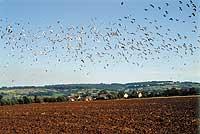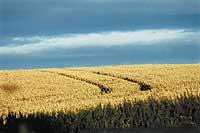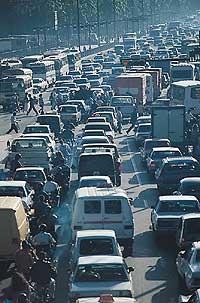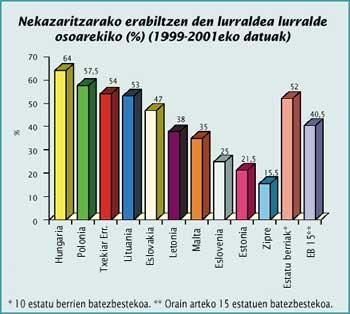Old land in the new Europe
Ten states entered the European Union on 1 May. Eight of them belong to Central and Eastern Europe, and the other two belong to the Mediterranean islands.
Despite local differences, the first eight have evolved similarly in agriculture. Compared to the fifteen States that existed in the European Union (EU-15), production is low, reduced use of fertilizers and pesticides, as well as the abundance of plant and animal species.
In most cases, agricultural land use is higher in newly introduced countries. In fact, more than 50% of the total land is allocated to agriculture, while in the EU-15 it is around 40%. The weight of this sector in gross domestic product is also higher.
On the other hand, the average size of the plots is low compared to the EU-15, while small farms that rise in half, despite being decreasing, are much more. In these farms only part of the products produced are sold. Large plots are much less, but have a higher productive weight. Although many once belonged to the State, they are now private or collective properties.
On the other hand, they present a wide variety of unaltered seminal habitats, from this point of view they have developed agricultural systems of high natural value in various regions. They are more traditional, extensive and sustainable, and are often associated with important conservation areas.

In these pastures, both wet and dry, livestock have a role in the ecosystem and some species of rare birds in the EU-15 are much more abundant in the new States. For example, the gilones that inhabit the meadows ( Crex crex) are more than 90,000 and in the EU-15 only 4,000. These conservation areas total seven million hectares.
Agriculture and environment
To reach this current situation, the socio-economic changes of the past decade have had a great influence. The sharp decline in investments in the sector had several consequences.
On the one hand, the use of pesticides and fertilizers was reduced, so pollution also decreased. On the other hand, the trend of previous decades slowed down. In fact, until 1990 intensive agriculture increased steadily in many territories. This increased production but also had other environmental consequences. In some cases, the cultivation of large areas meant the loss of ecosystems and landscape elements. At the same time, agricultural pollution increased.

In fact, agriculture produces a number of pollutants. On the one hand, ammonia can cause eutrophication and acidification of soil and surface water, and on the other hand, agricultural activities can release greenhouse gases in the form of methane and nitrogen oxide.
After the economic crisis, the situation has changed radically. Ammonia emissions are related to livestock. Since 1990 this sector suffered a sharp decline, which caused a decrease in emissions by almost half. The difference with the EU-15 is important since then. However, the risk of eutrophication remains high and acidification has not disappeared either.
The case of greenhouse gases has been similar. Since the beginning of investment limits, the use of nitrogen fertilizers has been reduced and methane emissions have been halved due to the decline of the livestock cottage.
On the other hand, machining slowed down, with the use of old machines and infrastructures being common since the start of the changes.
Finally, many of the grassland ecosystems with rich biodiversity have been abandoned or transformed in recent years, due to the large migration of agricultural areas to cities. In addition, investments in manure storage resources and manure treatment decreased.

The same happened with anti-erosion initiatives. Earth erosion has long been a major problem throughout Europe. The expansion of land, the use of inadequate machinery and some farming techniques have influenced this. The transformation of seminatural pastures into farmland, in addition to affecting biodiversity, increases this risk.
Implications of integration
For integration reasons, Member States will become dependent on the EU Common Agricultural Policy (CAP). This policy, on the one hand, allocates aid for the promotion of agriculture. On the other hand, he has received several criticisms in recent years for his specialization and the drive for intensive agriculture. Critics consider productivism to be above sustainability.
Therefore, two trends can be expected, according to experts. On the one hand, intensive cultivation will be expanded. This will result in greater use of fertilizers and pesticides, as well as increased machining and, in the long term, impoverishment of the soil. In addition, the transformation of pastures, multi-year forage crops or long-lasting fallow lands into sowing lands can increase the risk of soil erosion.
On the other hand, they will stop growing less productive marginal lands from the productive point of view. All of this can affect pollution and biodiversity unless you learn from past problems.

However, EU forecasts suggest that intensification will not reach EU-15 levels and will only be representative in the most productive environments.
With less aid in the livestock sector, livestock will not reach the level they had before 1990. Therefore, they announce that air and water pollution levels will remain similar, especially in the case of ammonia and methane.
Therefore, the agriculture of the new States will contribute to the European Union meeting the emission levels set in Kyoto. However, eutrophication and acidification will not disappear and the use of nitrogen fertilizers will increase due to intensification.
On the other hand, there are predictions that suggest that an “invasion” of some Western states may occur in agriculture and other industries. In fact, the saturation of some areas of the sector is virtually unsustainable in some countries and investors will take the opportunity to travel to less pressured countries and receive subsidies.
All changes will require proper management so that, according to experts, risks do not come true. To do this, the European Union has environmental schemes.
They channel management and advice, trying to avoid the environmental problems that the agricultural sector can generate. However, skeptics consider that these schemes will not be enough. We will have to see evolution from now on.
Little water in the middle of the sea
There are differences between the ten States that have joined the European Union. However, two of them, Malta and Cyprus, are especially different in many areas, including agriculture and the environment.
In both Malta and Cyprus, where the plots are small, intensive agriculture has gradually increased in recent years. This has increased the need for irrigation and has meant excessive use of water resources. Water scarcity is one of the biggest problems these municipalities have.

In addition, to meet the needs of tourism it is necessary to use more and more water and underground reserves are about to run out. Desalination of sea water is becoming more and more frequent in Malta. In Cyprus, groundwater salinization has aggravated the problem, as in some areas this water cannot be used for both agricultural and domestic use.
Tourism needs have also influenced land use. In addition to the pressure imposed on the environment, more land is being withdrawn to crops and livestock, especially for construction works and leisure projects.
To these problems must be added the high soil pollution of some areas of Cyprus. Due to mining activity heavy metals and poisonous substances have been filtered to the soil, which has caused some crops to be poisoned. The political distribution of the island also makes it more difficult to find comprehensive solutions to these problems.
In Malta, for its part, the poor disposition to environmental problems has been one of the black points of integration. Despite having received subsidies in this area, they have not complied with the established plans. They do not have specific environmental legislation or nature protection standards, or comprehensive studies on pollution or the state of nature.
Some of its environmental associations and the European Environment Agency believe that its integration into the Union will serve to address all these problems. Others are less optimistic. In fact, by May 1 the laws had to be changed to adapt them to the Community directives, but the Government has already requested the authorization of postponement.
Cross-border problems
Pollution has a major impact on agriculture and the environment. In addition, when this pollution is atmospheric, it is very difficult to delimit its extension. In fact, contaminated air can penetrate long distances from sources. For example, gases emitted in Germany can cause damage in Poland or Poland in Finland, making it difficult to manage solutions.

This is the case of acid rain, for example. It is an old problem in Europe and today it is still large, especially in the north and in the center. According to measurements made in the 1990s, one in four European trees suffer some kind of damage from acid rain.
This harmful rain is produced by various gases emitted by industry, road transport, etc., mainly nitrogen oxides (NO x), sulfur dioxide (SO 2) and ammonia (NH 3). When combined with water molecules in the air they produce acids. These acids reach soil and water with rain and alter their composition. This causes great damage to ecosystems.
For example, important elements are lost in plant cultivation. On the other hand, the movement and filtering of heavy metals is continuous. Consequently, not only direct damage to soil and water occurs, but also to plants.
Emissions of some gases have decreased in recent years, especially OS 2. However, each year the emission limits set by Europe, especially NO x, are exceeded, not achieving the targets set for 2005.
Buletina
Bidali zure helbide elektronikoa eta jaso asteroko buletina zure sarrera-ontzian













